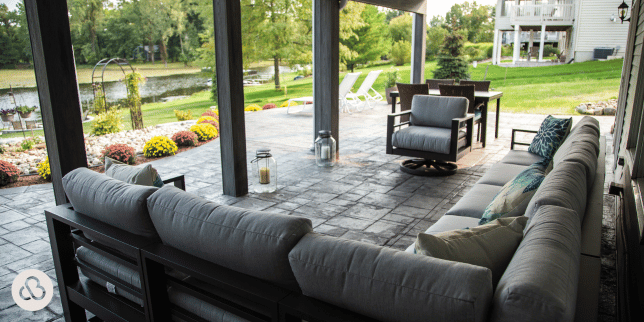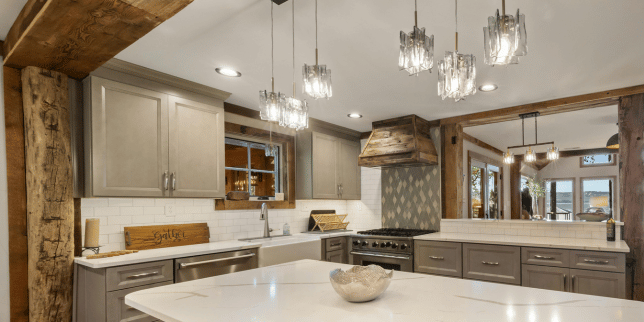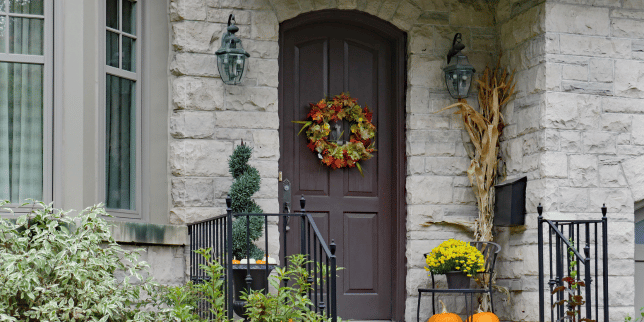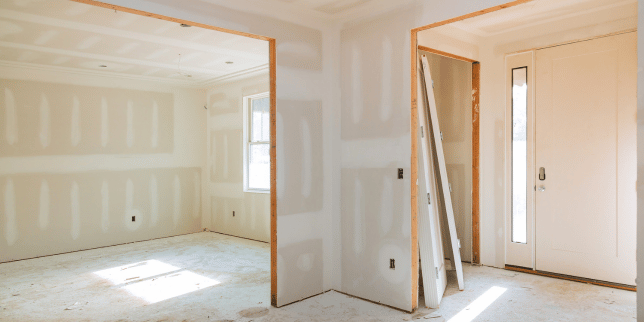Top 4 Differences Between a Design-Build Firm and a General Contractor
June 1st, 2023
6 min read

Choosing between contractors for your home remodeling project? With so many options, it’s overwhelming to figure out which firm to hire - especially when they all look similar.
Even worse? Hiring the wrong company could result in poorly crafted spaces and wasted money.
Fortunately, a tad bit of research can help you tell the difference between each one and make a more informed decision.
With over 15 years of design-build experience, our team has completed hundreds of beautiful home remodels and understands the importance of hiring a construction company that honors your budget and service needs.
When it comes to home remodeling projects, design-build firms and general contractors each offer various advantages.
In this article, you will learn more about the top 4 differences between a design-build firm and a general contractor and which option best fits your vision:
What is a Design-Build Firm?
A design-build firm, such as Custom Built, consists of a designer and builder or general contractor that collaborates under one roof. When you hire a design-build firm, you work with their design team first to create your plans, then with the production team to build your project.
What is a General Contractor?
A general contractor is an individual or company that oversees the build portion of your project. At the start of your project, they will receive designs from your original architect or designer, then hire subcontractors to complete each aspect of your build (i.e. carpenter, plumber, electrician, etc.).
Differences Between a Design-Build Firm and a General Contractor
Aside from differences in name, there are a few key areas that separate design-build firms and general contractors from each other. Most of these distinctions happen at the very start of your project, more commonly known as the “design phase.” Here’s how each team handles the following project components:
1. Understanding of Your Project’s Design During Construction
Throughout a build, most project decisions are based on the original architect’s designs. When all is said and done, both teams rely on those plans to execute your true vision from the beginning. There’s a small, yet impactful difference in how they use your designer's schematics though:
Design-Build Firm
- Unified vision and understanding of your project’s design and scope.
Thanks to strong chemistry developed over many years, design-build firms use their heightened sense of internal communication to voice, plan, and deliver consistent results.
With both architects and builders working under the same roof, there’s a collective understanding of your original vision, leading to less overall team confusion.
This will also speed up the time that your job can start, as the design portion of your build integrates seamlessly into the construction phase.
General Contractor
- External designer’s plans are used as a general contractor’s framework, without working under the same roof.
General contractors and architects interact as needed but will not be as efficient, as both are regarded as separate parties. Should your plans require a tweak as construction beings, you might have to go back and reintroduce your architect to your original and updated blueprints to edit and reignite the build phase.
Typically, a general contractor might not start production until 3 to 6 months after you meet with your architect, with your design going through a bid process before it’s chosen and given more set project timelines.
2. Flexibility to Change Plans During a Build
Changes and issues happen on the job. It’s a truth that most, if not all, companies accept and are prepared for. When it comes to design-build firms versus general contractors, however, one team has a slight edge over the other when it comes to flexibility.
Imagine you’re in the middle of a kitchen remodel. Now that you’ve seen the empty space, now you decide you want to increase the size of your island:
Design-Build Firm
- In-house design team capable of jumping on edits to reduce slow down of production.
Design-build firms approach a design change by using “change orders.”
A change order essentially stops production so the design and build teams can restructure to accommodate your project’s proposed edits (paint color changes, pantry size increases, etc.). With a design-build firm, you have direct access to your main designer or architect, making change orders less time-consuming and less expensive.
Since designers and builders work together on the same project, you only have to pay for one change order, eliminating the need to re-hire a 3rd-party architect to edit your designs.
General Contractor
- Homeowners must contact a 3rd-party architect which will increase time loss.
General contractors aren’t tied to the original architect. Thus, they can more flexible with some mid-project pivots. A general contractor can contact their preferred hardwood floor specialist in one phone call and delegate the task.
However, proposed design changes need to be estimated all over again without the presence of an in-house design team. Since third-party architects don’t work directly with general contractors, communication and progress might not be as efficient, therefore causing longer delays in a change order.
3. Size of Projects Handled by Contracting Teams
The construction industry is filled with a wide selection of experienced builders. Whether you hire a design-build firm or general contractor, both options guarantee years of professional know-how that’ll successfully transform your home.
Here is the kind of professional expertise and projects you should expect from both teams:
Design-Build Firm
- In-house specialists with multi-trade experience.
Design-build firms are commonly made up of experienced carpenters and multi-trade builders - each with years of professional expertise under their belts. Due to their size and trade experience, design-build teams are more nimble with smaller projects such as:
- Bathroom remodels
- Kitchen remodels
- Deck remodels
- Home additions
Additionally, on any given project, they can subcontract non-mechanical trades excluding services such as electrical, plumbing, or HVAC work (these require additional licenses for their perspective trades).
For instance, design-build firms can hire subcontractors to install framing insulation for drywall paint flooring, as well as other experts if the job calls for their skills.
This keeps all jobs moving depending on the load of work in progress. If the weekly workload is slower, design-build firms may attend to more trades in-house to keep their staff working versus hiring outside trade experience.
At its core, owning in-house labor gives design-build companies more control over the calendar, encouraging better time management and project consistency.
General Contractor
- Subcontractors with specialized experience.
General contractors hire similarly to design-build firms, in that they can hire subcontractors from a pool of talented experts. Here’s the difference, though: general contractors subcontract every aspect of your project.
This grants them access to a variety of professionals who have most likely worked with your prospective contractor before, welcoming more trust between builders on the job.
While your traditional design-build firm might employ workers with experience in 6 trades under one roof, general contractors can scale their teams with experience in 10 trades or more depending on the project.
This means that general contractors are more equipped and likely to accept jobs such as:
- Re-roofing larger residential homes Large home additions
- Whole house remodels
- Full apartment complex remodel
Keep in mind that general contractors will still be willing to accept home remodeling projects similar to what design-build firms commonly work on. However, general contractors might have trouble hiring a subcontractor for one smaller job as opposed to larger projects with bigger scopes.
4. Communication Needs Among Clients and Contracting Teams
No matter what kind of project you hire for, communication is one of the most important factors in a successful build. From initial planning to mid-project updates, developing a rapport with your construction team varies between both options:
Design-Build Firm
- Direct contact with one team.
With one team walking you through every phase, a design-build firm’s direct communication simplifies the exchange of ideas, questions, and rapport - something crucial for first-time clients.
General Contractor
- Contact with several teams.
Unlike design-build firms, you collaborate with a general contractor and designer separately. On top of that, you also interact with the various subcontractors your general contractor hires - a huge reason why they are recommended for clients looking for a more hands-on approach.
Which construction company is right for you?
A design-build firm is right for you if:
- You want to stick to a fixed-price agreement.
- You want one team to interact with throughout your build.
- You aren’t familiar with/sure about how to navigate the process.
- You want to approve changes as they occur during your remodel.
Much like a coach or teacher, a design-build firm will help you visualize and bring your vision to life.
A general contractor is right for you if:
- You don’t mind interacting with more than one team.
- You want your design solidified before committing to a contractor.
- You want a more hands-on project experience coordinating between your contractor and a 3rd-party designer.
- You want more flexibility about who you want to work with from design to construction - rather than being tied to one team.
There is more coordination on your end between designers and contractors, but opting for this route opens the door to vetting several construction options that can execute your finalized design plans.
Next steps for hiring your construction company
Searching for a construction team to trust with your dream home build can be exhausting - especially with your hard-earned cash in the balance.
Taking the time to interview multiple firms and scroll through their Google reviews will help you decide more about the kind of project process, dynamic, and budget you want to secure.
After reading this article, you understand the top 4 differences between a design-build firm and a general contractor, and which option best suits your home remodeling project.
We are a design-build firm first. Yet, we at Custom Built care about giving you the tools to find the right organization for your lifelong remodeling goals.
To learn more about finding the right home remodeling firm/contractor for you, read the following articles:
- How To Properly Vet a Remodeling Contractor
- 6 Ways to Build a Successful Partnership with Your Contractor
Michael brings over 2 decades of building and remodeling experience to his position as the Owner and Visionary of Custom Built. Michael’s passion to make an impact on the home building industry has led him to serve for over ten years at the local and state Home Builders Association, culminating as President of the HBA of Michigan in 2020.
Topics:


























